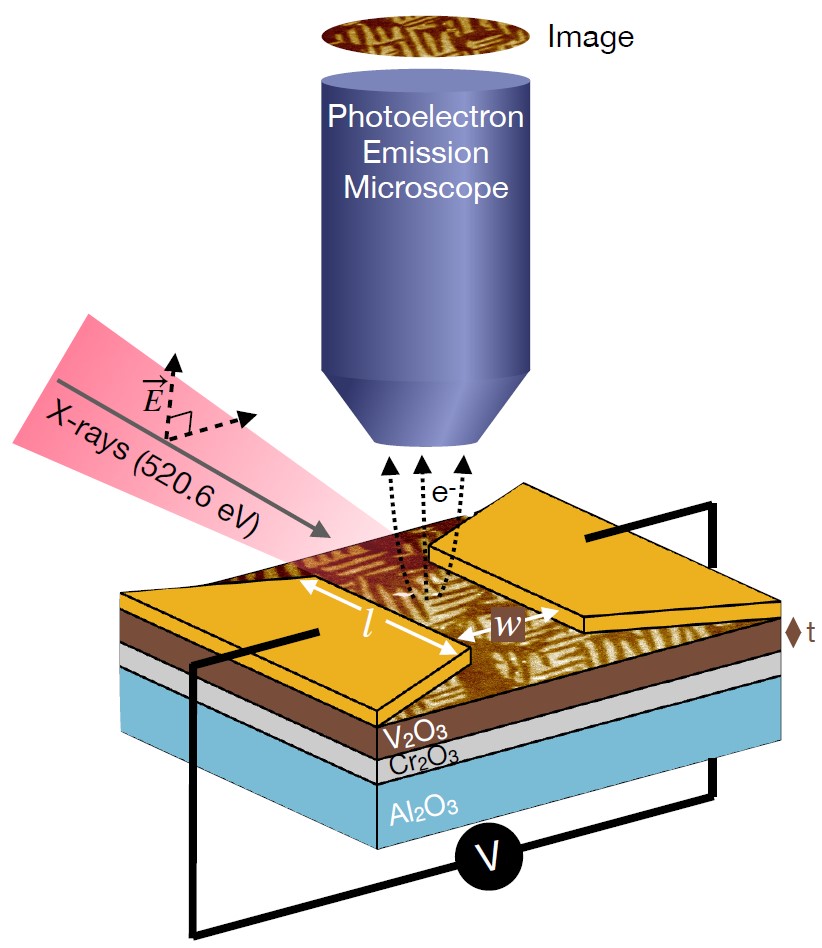A new mechanism controlling resistive switching in Mott materials discovered
07.11.2024
 |
|
Schematics of the experimental setup: The V2O3 film is coated with gold metal electrodes, allowing to drive a current through the device while simultaneously acquiring XLD-PEEM images. Credit: Alessandra Milloch. |
- The resistive switching process in V2O3 is driven by topological defects of the underlying lattice nanotexture.
- The discovery of an intimate relation between the topology of the lattice order parameter and the firing mechanism in Mott devices can impact ultrafast electronics.
| Tweet |
Madrid, 7th November, 2024. Scientists discovered that the resistive switching process in a paradigmatic Mott material, V2O3, is driven by topological defects of the underlying lattice nanotexture. By performing X-ray based Photoemission Electron Microscopy (PEEM), a group of researchers from Università Cattolica del Sacro Cuore, IMDEA Nanociencia, KU Leuven, SISSA and Diamond Light Source, imaged for the first time the formation of a nanometric metallic channel in a V2O3-based device under operating conditions. The discovery of an intimate relation between the topology of the lattice order parameter and the firing mechanism in Mott devices can impact ultrafast electronics, neuromorphic devices, resistive memories and brain-inspired computation.
The work has been published in Nature Communications: https://doi.org/10.1038/s41467-024-53726-z
“Resistive switching is the fundamental process at the basis of the sudden change of the electrical properties in solid-state devices under the action of intense electric fields”, explains Alessandra Milloch, Università Cattolica del Sacro Cuore. “Despite its technological relevance, this process was believed to be stochastic in nature, driven by local and incontrollable fluctuations. We decided to go more in detail and investigate the real nature of this phenomenon in planar devices constituted by two metallic contacts deposited on top of a thin film of V2O3, which is one of the most celebrated examples of Mott insulators”.
“Mott insulators are fundamentally different from conventional insulators, since their poor conductivity is determined by the strong interactions among the electrons moving throughout the lattice”, adds Ignacio Figueruelo, IMDEA Nanociencia. “In this class of materials, comprising many transition metal oxides, a small change of the external parameters, such as the applied voltage and pressure or light photoexcitation, can induce a dramatic change of the electric properties and the release of a number of conducting electrons of about 1 per unit cell, which is many orders of magnitude larger than what can be achieved in conventional semiconductors by means of doping. This intrinsic non-linearity triggered a huge interest to address the possible use of these materials as building blocks for a novel family of devices, thus leading to the development of a new field dubbed Mottronics.”
Dr. Mariela Menghini, one of the coordinators from IMDEA Nanociencia, explains: “in previous experiments we discovered that the insulating ground state of this material is inherently inhomogeneous. The low temperature electronic transition is accompanied by a distortion of the lattice, which can take place along three equivalent directions. Among the three possibilities, the system minimizes the energy by forming a spatial nanotexture of stripy nanometric domains, whose boundaries follow well defined mathematical rules. When these constraints cannot be respected at some peculiar intersection points, nanometric topological defects are formed. Indeed, it is at these specific points that the insulator-to-metal switching takes place when a well-defined threshold voltage is overcome. The observation of this peculiar nanotextured Mott insulating state was possible thanks to the high-quality V2O3 samples grown by the group of Prof. Jean-Pierre Locquet at KU Leuven.”
“This discovery required a beyond state-of-the-art experiment combining nanometric microscopy, sensitive to the lattice nanotexture, with the possibility of applying a voltage in situ during the measurements.” explains Claudio Giannetti, Professor of Physics at Università Cattolica del Sacro Cuore. “We realized this experiment at the Diamond Light Source in UK, where it was possible to take images of the opening of a metallic channel while applying an above threshold voltage across the device. This discovery is important because it sheds light on the mechanism behind the transformation from insulator to metal in these materials. Our experimental results are well supported by a theoretical model developed by Prof. Michele Fabrizio from SISSA. Now that we know that the transformation is triggered by topological defects, we can design new experiments to pin such defects and control the switching process with the goal of achieving complete controllability of the process and engineer devices working at unprecedented speed and with extremely low power dissipation.”
Reference:
Milloch, A., Figueruelo-Campanero, I., Hsu, WF. et al. Mott resistive switching initiated by topological defects. Nat Commun 15, 9414 (2024). https://doi.org/10.1038/s41467-024-53726-z
![]() https://repositorio.imdeananociencia.org/handle/20.500.12614/3815
https://repositorio.imdeananociencia.org/handle/20.500.12614/3815
Contact:
Mariela Menghini
This email address is being protected from spambots. You need JavaScript enabled to view it.
Transport in Quantum Materials Group, IMDEA Nanociencia, Madrid, Spain
https://nanociencia.imdea.org/transport-in-quantum-materials/home
Claudio Giannetti
This email address is being protected from spambots. You need JavaScript enabled to view it.
Interdisciplinary Laboratories for Advanced Materials Physics (i-LAMP) &
Università Cattolica del Sacro Cuore, Brescia, Italy
https://centridiricerca.unicatt.it/ilamp-home
Oficina de Divulgación y Comunicación en IMDEA Nanociencia
divulgacion.nanociencia [at]imdea.org
Twitter: @imdea_nano
Facebook: @imdeananociencia
Instagram: @imdeananociencia
Source: IMDEA Nanociencia.




